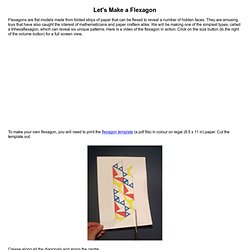

Flexagon. A hexaflexagon, shown with the same face in two configurations.

Flexagons are usually square or rectangular (tetraflexagons) or hexagonal (hexaflexagons). A prefix can be added to the name to indicate the number of faces that the model can display, including the two faces (back and front) that are visible before flexing. For example, a hexaflexagon with a total of six faces is called a hexahexaflexagon. In hexaflexagon theory (that is, concerning flexagons with six sides), flexagons are usually defined in terms of pats.[1][2] Two flexagons are equivalent if one can be transformed to the other by a series of pinches and rotations. History[edit] Discovery and introduction[edit] The discovery of the first flexagon, a trihexaflexagon, is credited to the British student Arthur H. Attempted commercial development[edit] In 1955, Russell Rogers and Leonard D'Andrea of Homestead Park, Pennsylvania applied for a patent, and in 1959 they were granted U.S.
Varieties[edit] Tetraflexagons[edit] Meet the hexaflexagon. It's about to blow your mind. Crafty Coaster: flex the flexagon. Let's Make a Flexagon. Let's Make a Flexagon Flexagons are flat models made from folded strips of paper that can be flexed to reveal a number of hidden faces.

They are amusing toys that have also caught the interest of mathematicians and paper crafters alike. We will be making one of the simplest types, called a trihexaflexagon, which can reveal six unique patterns. Martin Gardner and Flexagons. Introduction: The story of the Flexagon. Next: Building and Operating the Up: FLEXAGONS Previous: Contents We may safely conjeture that such a simple object as the first flexagon must have been discovered long ago, and perhaps many times since.

For example, there are reports of such a device existing in elementary schools in pre-war Vienna. The work on the flexagon came as a result of its discovery at Princeton in 1939. The story has it that Arthur Stone, an English graduate student, was in the practice of doodling with the strips of paper that he cut from around the edges of his notebook paper. American paper was too large for his English binder. The members of this group - Richard P. It is, however, chiefly due to three influences that flexagons are as well known as they are today.
In this article, the authors hope to bring together much of the information that has been distributed concerning flexagons, along with the results of their own investigations. Building and Operating the Flexagon. Next: The Covering Space Representation Up: FLEXAGONS Previous: Introduction: The story of The first flexagon was a hexagonal object folded from a straight strip of paper.

This simplest model is quite easily constructed. Fold off and cut out a sequence of equilateral triangles (see figure 1.1a). Nine of these are to be used in the flexagon. Folding up the flexagon is accomplished by folding consistently clockwise or counterclockwise at every third hinge between triangles (see figure 1.1). It will not hold together. It can now be seen that this flexagon is a kind of three twist Moebius band.
Each triangle of paper making up the pats is called a ``leaf". This is all very interesting, you may say, but what of the supposed ``flexibility"? Flexagon Portal - Home. Flexagons. Flexagons. In 1939 a Princeton graduate student, Arthur Stone, played around with a strip of paper trimmed from his notebook and created the first flexagon.

A flexagon is a polygon, usually made from paper, that can be folded in certain ways to produce a series of faces. If that description didn't make any sense, you have two options: visit the homepage of David King and look at his very excellent Java Flexagon Animation . Otherwise you can continue reading and it should all make sense after constructing one yourself. Flexagon Fever. Flexagon Fever This is an article about flexagons. What is a flexagon, you ask? At first glance it looks innocuous enough, like a folded hexagon or square, a child's fortune teller or cootie catcher, or a piece of origami. But look closely and you'll see hidden layers lurking between the front and back. When you fold or pinch corners together, the flexagon "flexes," meaning a formerly hidden layer will come to light as the top layer folds underneath. Mathematicians refer to flexagons as "mathematical oddities.
" This article is about flexagons and the people who love them. How to Fold a Hexatetra Flexagon – The Museum of Mathematics. How to Fold a Hexa-tetraflexagon 1.

Take out our flexagon. 2. First, use scissors to cut around the outside of the 8” x 8” large square.